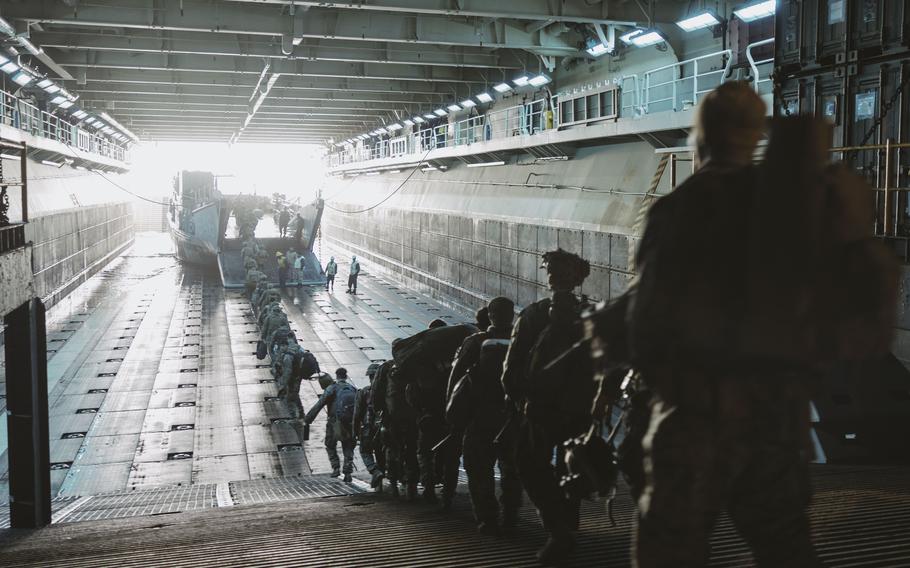
Marines and sailors board a landing craft before departing the amphibious assault ship USS Boxer in the Pacific Ocean on Nov. 23, 2024. (Joseph Helms/U.S. Marine Corps)
NATIONAL HARBOR, Md. — About 50% of amphibious warships are ready at any given time to deploy if needed for a crisis or conflict — far less than the Navy’s goal of 80% — the Marine Corps commandant said Monday.
The Navy set a goal in 2024 to have 80% of its force — including ships, submarines and aircraft — trained, equipped and ready to deploy at a moment’s notice. Ships, submarines and aircraft are hovering at about a 67-70% readiness, Navy leaders said Monday during the 2025 Sea Air Space Symposium. But the Navy’s amphibious warships, which transport Marine Corps forces when they must deploy, are lagging behind.
“Without those ships, Marines can’t get to the fight,” said Gen. Eric Smith, commandant of the service.
The Navy has 32 operational amphibious ships — just one more than the Congress-mandated minimum of 31 ships. An amphibious ready group, which typically includes one assault ship, one dock landing ship and one transport dock, moves Marines and their equipment, including vehicles and aircraft, for assault and humanitarian missions. But half the fleet is in poor condition, and some ships have been unavailable for years at a time, the Government Accountability Office reported in December.
“The amphibious maintenance has been vexing us. We had significant trouble with the [USS Boxer and USS Wasp] last year,” said Vice Adm. James Kilby, the acting chief of naval operations, the Navy’s top operational job.
In 2024, the USS Boxer amphibious ready group and its Marine Expeditionary Unit experienced operational challenges that resulted in a delayed deployment and missed exercises due to lack of available ships. Maintenance problems forced the Boxer to return to California in April 2024, just days into its first deployment in five years for “additional maintenance in support of its deployment,” the Navy said at the time. The delayed deployment came after a 2020 maintenance period stretched into two years — about seven months longer than planned — followed by an additional year of mechanical problems. The maintenance issues interrupted training meant to certify the ship for deployment.
Also in 2024, ship spotters observed the USS Wasp in March and the USS Iwo Jima in September limping back to port following training exercises off coast of Virginia. In both instances, Navy officials confirmed the ships had experienced mechanical problems.
As a result, the Navy and Marines Corps have struggled to keep three amphibious ships per ready group operational.
But Kilby said getting amphibious ship maintenance back on schedule has his full attention.
“The United States Navy owes it to the Marine Corps to produce a three-ship [amphibious ready group] where they can train and go through that certification process to deploy on time — not in a non-connected manner as we saw with Boxer,” he said, referencing to the Boxer’s interrupted training due to mechanical issues.
The USS America, an amphibious assault ship, will undergo what the Navy calls a “signature maintenance availability” in the fall. A signature availability, Navy leaders said, takes a new approach to how the service plans and conducts maintenance on amphibious warships. The new approach aims to determine what maintenance needs to be done 500 days before starting the work and award the contract to contractors about one year before the overhaul begins.
“With these complex [availabilities] for a big deck amphib, the lead maintenance activities are going to need some more time,” Vice Adm. Brendan McLane, the commander of Naval Surface Force, said during a panel at the symposium.
Navy leaders said deciding what work needs to be done on the ship more than one year in advance allows for more time to plan the maintenance and will ultimately reduce delays. Advance notice, McLane said, will also ensure contractors can pre-order necessary parts to have them in stock, rather than having to stop maintenance work to wait for parts to arrive.
While the Navy works to maintain its degrading amphibious ships, the service is also looking to expand its force. The Navy struck a deal last year to pay nearly $10 billion to build three new amphibious warships to satisfy the congressional demand to have 31 operational amphibious ships. But it will be years before those ships join the fleet.
“Progress is possible here, but it’s going to take time to fully restore this capacity,” Smith said.
He said his goal as commandant is to maintain a three-ship amphibious ready group.
“I’m looking to what the future requires,” Smith said. “You don’t know when you’re going to need to evacuate Americans from a war-torn country. You don’t know when you’re going to need to strike, and you don’t know when you’re going to need to execute a [humanitarian assistance, disaster relief]. You just don’t know.”